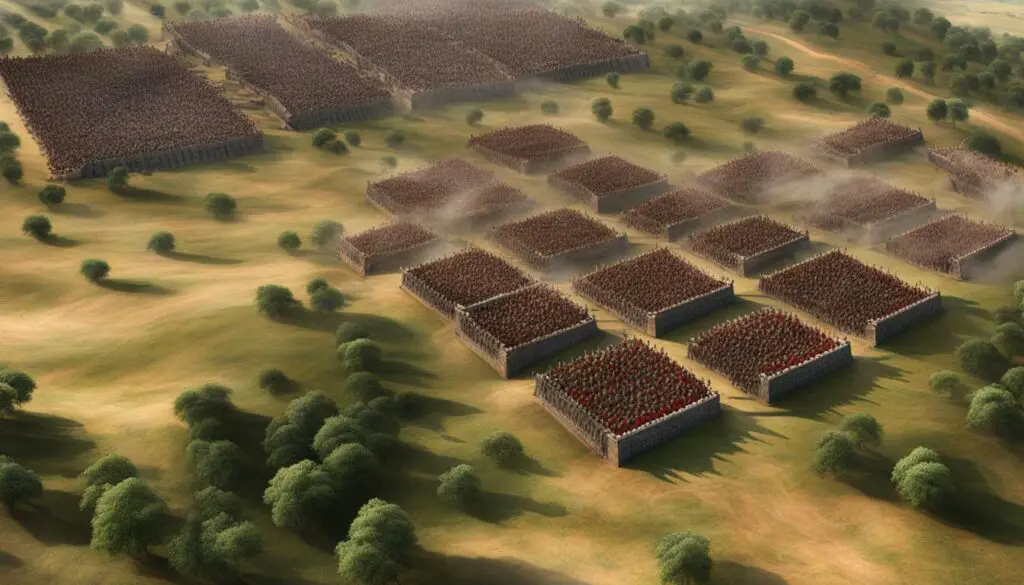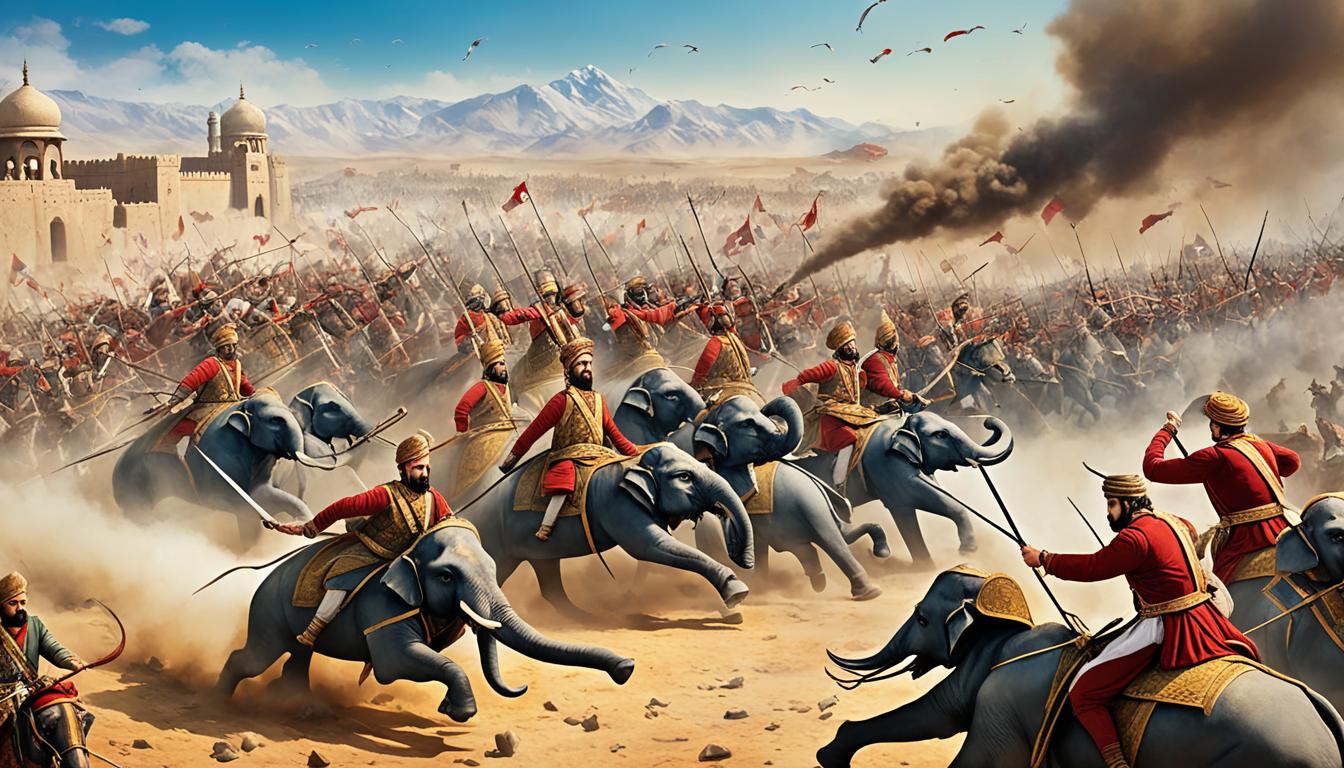Have you ever wondered about the key events that shaped the Mughal Empire’s rule in India? Did you know that a decisive battle between the Mughal forces and the Rajput alliance played a crucial role in establishing Babur’s reign? Let’s explore the Battle of Khanwa, a historic clash of power that took place on March 16, 1527.
Key Takeaways:
- The Battle of Khanwa was fought between the Mughal forces led by Babur and the Rajput alliance led by Rana Sanga of Mewar.
- Babur’s desire to fulfill his ancestor Timur’s legacy and the decline of the Delhi Sultanate under the Lodi Dynasty led to the Mughal conquest of the Punjab region.
- Rana Sanga built a grand alliance to drive Babur away from India, but the battle ended in a decisive victory for the Mughals.
- Babur employed a defensive strategy with fortified encampments and firearms to counter the Rajput numbers.
- The Battle of Khanwa marked the beginning of the Mughal Empire’s rule in India and the decline of Rajput power.
Now, let’s delve into the strategic factors and army composition in the Battle of Khanwa.
Strategic Factors and Army Composition in the Battle of Khanwa
The Battle of Khanwa witnessed various strategic factors and the composition of the armies involved. In order to counter the overwhelming numbers of the Rajput cavalry, Babur devised a defensive strategy to neutralize their impact. He constructed fortified encampments equipped with Mughal artillery, which unleashed a devastating blow on the charging Rajputs. This defensive approach instilled confusion and fear within the Rajput ranks, disrupting their initial attacks.
To further enhance their defensive strategy, Babur implemented carts fastened together to protect their firing positions. This offensive-defensive formation involved stationing heavy Turkic horsemen behind the carts, while elite horsemen were held in reserve for a potential flanking maneuver. These tactical decisions aimed to counteract the relentless pushback of the Rajput cavalry and maintain Mughal superiority on the battlefield.
However, the battle took a turn when Rana Silhadi betrayed the Rajput alliance and aligned with Babur’s forces. This act of betrayal shifted the balance of power in favor of the Mughals and forced the Rajputs to adapt their entire battle plan.
The Khanwa War witnessed a formidable warrior team led by Rana Sanga, comprising Rajput kings from various clans and Afghan chiefs who had declared Mahmud Lodi as the Sultan. While the Rajput alliance held numerical superiority over the Mughal army, Babur’s defensive strategy and Rana Silhadi’s betrayal played a pivotal role in securing the Mughals’ victory.

Army Composition at the Battle of Khanwa
| Rajput Alliance | Mughal Forces |
|---|---|
| Rana Sanga | Babur |
| Rajput Kings from various clans | Mughal military with experienced commanders |
| Afghan chiefs supporting Mahmud Lodi as Sultan | Elite horsemen stationed in reserve for strategic maneuvers |
The Rajput alliance, driven by the objective to preserve the Indian nation and repel the Mughal invasion, consisted of Rajput kings from different clans. Afghan chiefs who pledged their loyalty to Mahmud Lodi, the proclaimed Sultan, also joined their forces. In contrast, the Mughal forces were led by Babur himself, with a well-organized military comprising experienced commanders. Moreover, the Mughals strategically stationed elite horsemen in reserve, ready for decisive flanking maneuvers.
The Battle of Khanwa was characterized by Babur’s defensive strategy and the strategic composition of the armies involved. Despite being outnumbered, the Mughals successfully employed their defensive tactics, aided by Rana Silhadi’s betrayal. This turned the tide in their favor, leading to a victorious outcome and solidifying the Mughal position in India.
Aftermath and Significance of the Battle of Khanwa
The Battle of Khanwa between the Mughals and the Rajput alliance had far-reaching consequences. With their victory at Khanwa, the Mughals solidified their control and established the mighty Mughal dynasty. This victory, coupled with the earlier triumph at the Battle of Panipat, marked a turning point in Indian history.
However, the Battle of Khanwa also brought about a decline in Rajput power. The Mughals introduced advanced warfare tactics, employing muskets and cannons that proved highly effective against the traditional methods of the Rajputs and other Indian kingdoms. This marked the beginning of gunpowder warfare in the Indian subcontinent and led to the adoption of modern military strategies.
Babur’s conquest at Khanwa not only shaped the future of Indian history but also left a profound impact on the cultural heritage of the region. The Mughal Empire that emerged from this battle went on to rule India for centuries to come. It represented a clash of cultures and showcased the significance of strategic decision-making in shaping the course of history.
The aftermath of the Battle of Khanwa highlights the importance of military tactics and the adaptability of armies in achieving victory. This historic event remains a significant part of Indian history, symbolizing the rise of the Mughal dynasty and the decline of Rajput power, and leaving an indelible mark on the Indian subcontinent.
FAQ
What was the significance of the Battle of Khanwa?
The Battle of Khanwa was a decisive victory for the Mughal forces led by Babur. It solidified the rule of Babur and his descendants, establishing the Mughal Empire’s control over India for centuries to come. It is also relevant for the IAS Exam.
Who were the main leaders in the Battle of Khanwa?
The battle was between the Mughal forces led by Babur and the Rajput alliance led by Rana Sanga of Mewar.
When did the Battle of Khanwa take place?
The Battle of Khanwa took place on March 16, 1527.
How did Babur manage to establish Mughal control over Punjab?
Babur was invited by Daulat Khan Lodi to invade Delhi but was betrayed. However, Babur managed to defeat Daulat Khan and establish Mughal control over Punjab.
What was the strategic factor employed by Babur in the Battle of Khanwa?
Babur employed a defensive strategy with fortified encampments and firearms to counter the overwhelming numbers of the Rajput alliance.
What was the composition of the armies involved in the Battle of Khanwa?
The Battle of Khanwa involved the Mughal army led by Babur and the Rajput alliance consisting of Rajput kings from various clans and Afghan chiefs.
What was the aftermath and significance of the Battle of Khanwa?
The victory at Khanwa solidified the establishment of the Mughal dynasty and marked a shift in warfare tactics in the Indian subcontinent. It also led to the decline of Rajput power and the beginning of the Mughal Empire’s rule in India.
Source Links
- https://leverageedu.com/blog/battle-of-khanwa/
- https://unacademy.com/content/railway-exam/study-material/history/short-note-on-battle-of-khanwa/
- https://byjus.com/free-ias-prep/battle-of-khanwa-1527/

